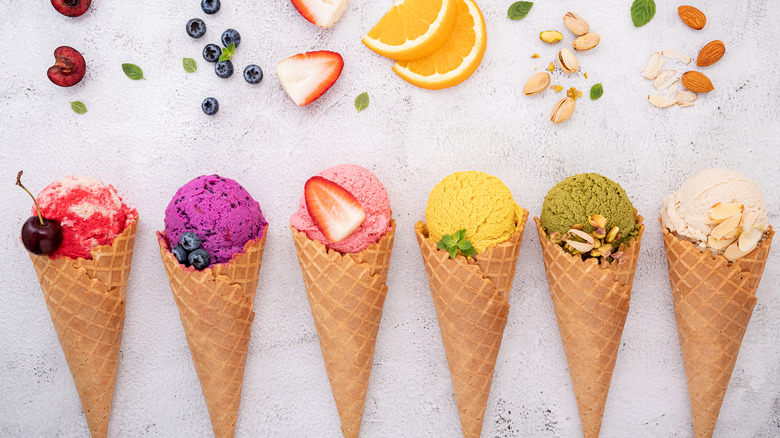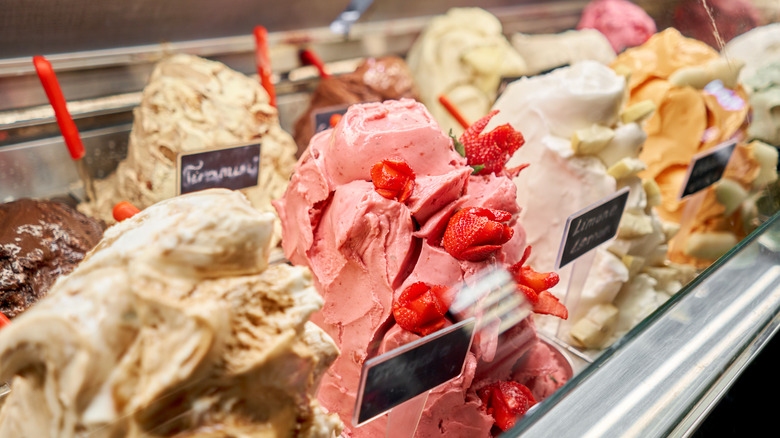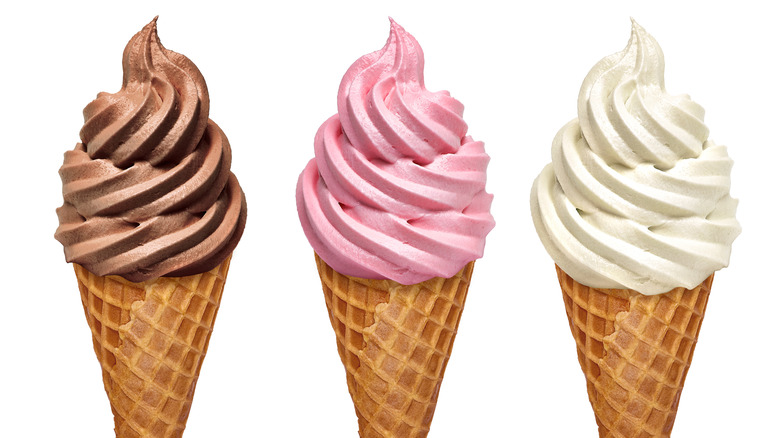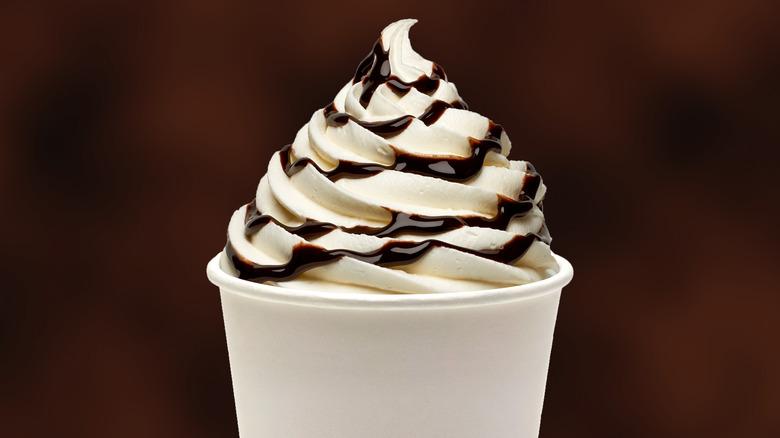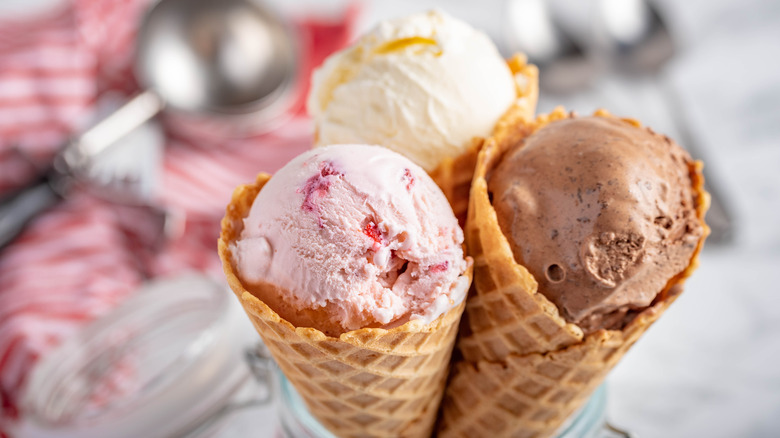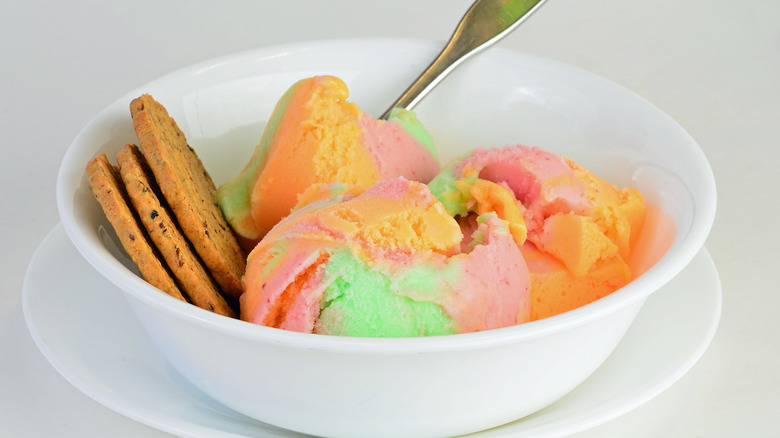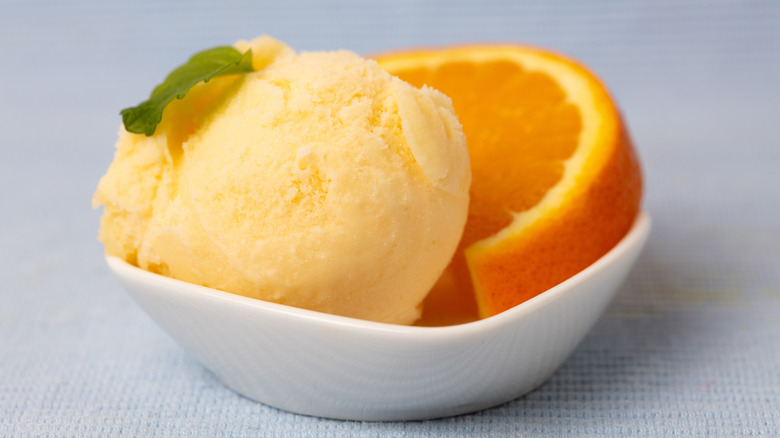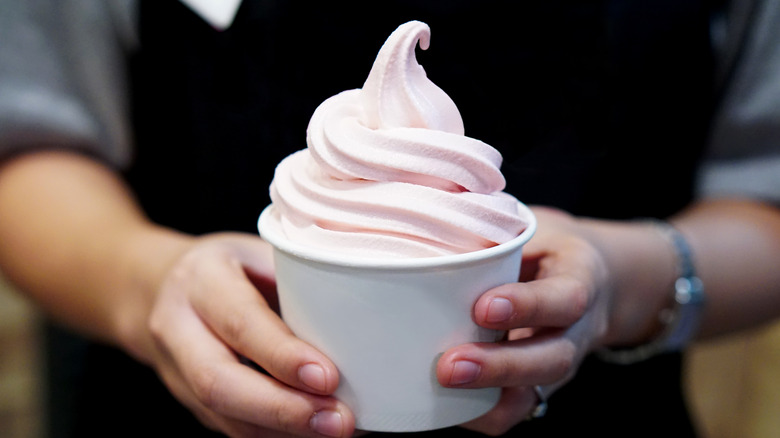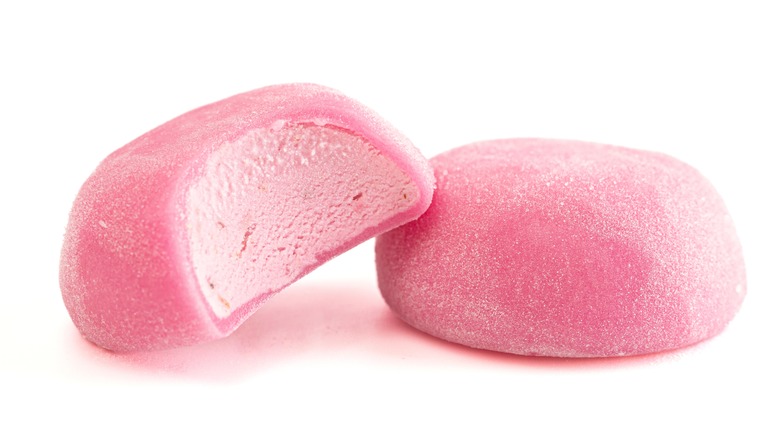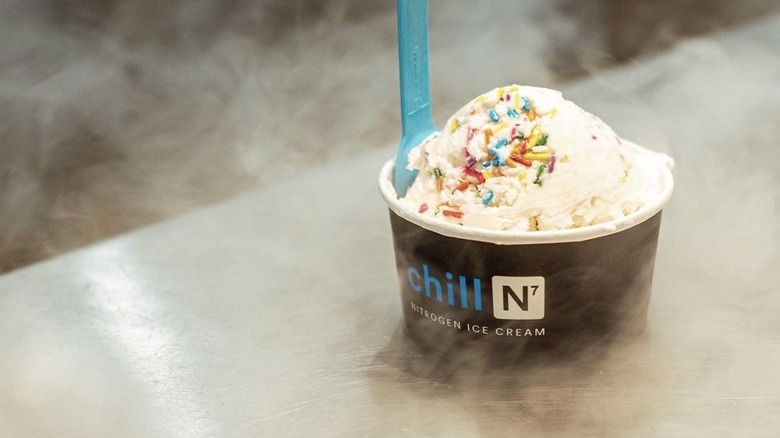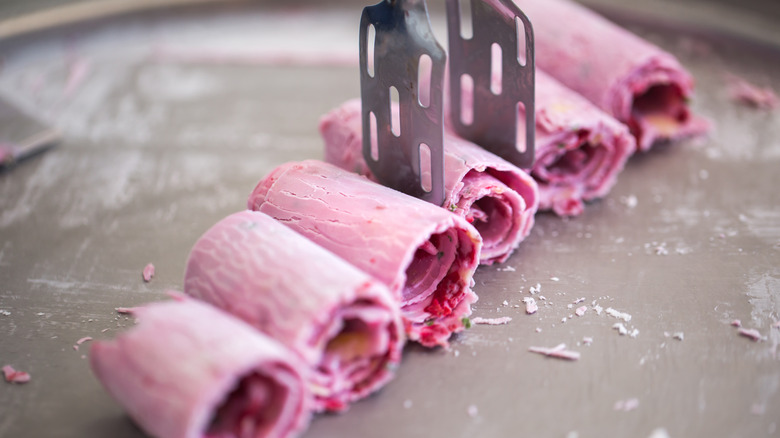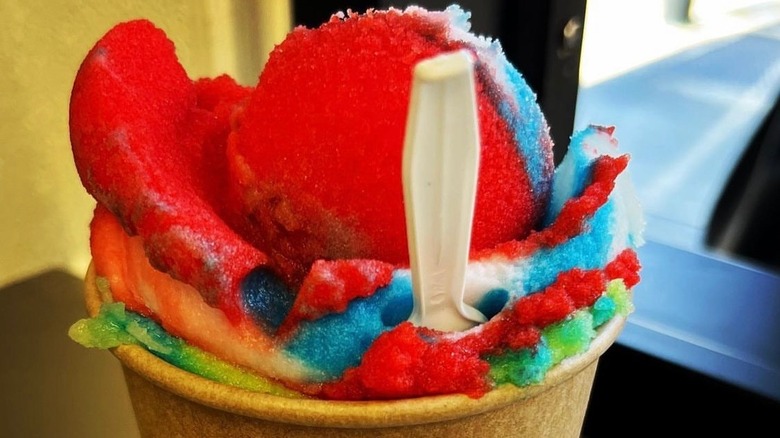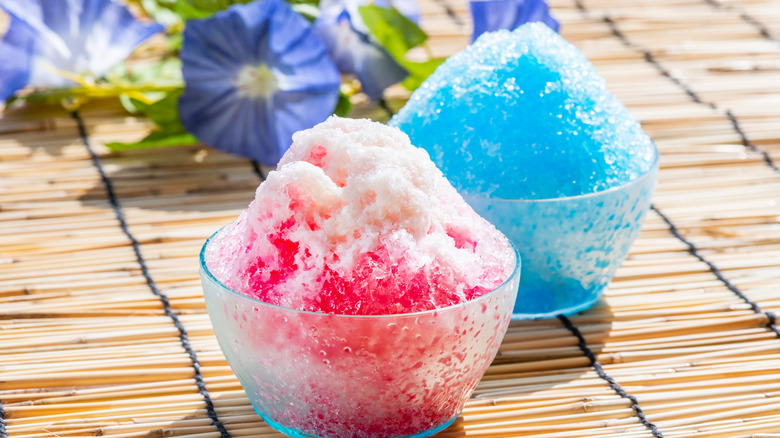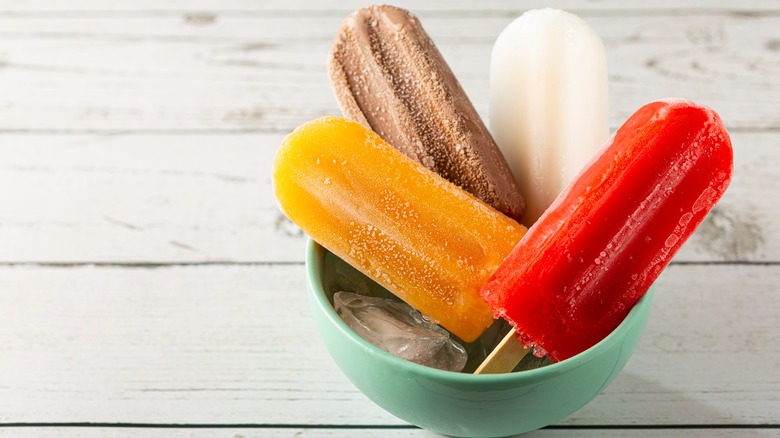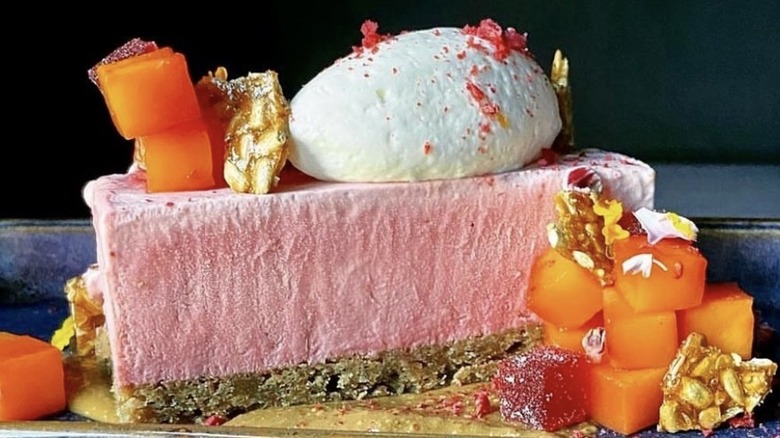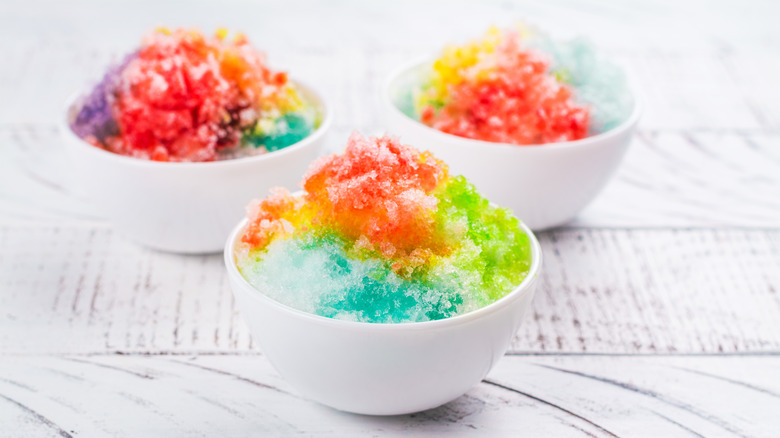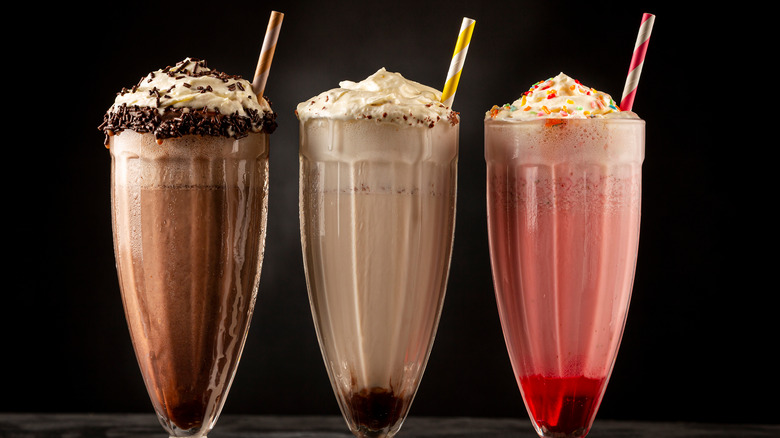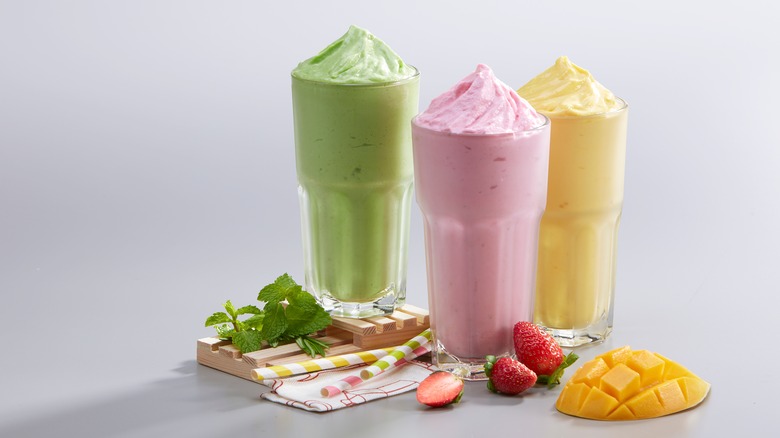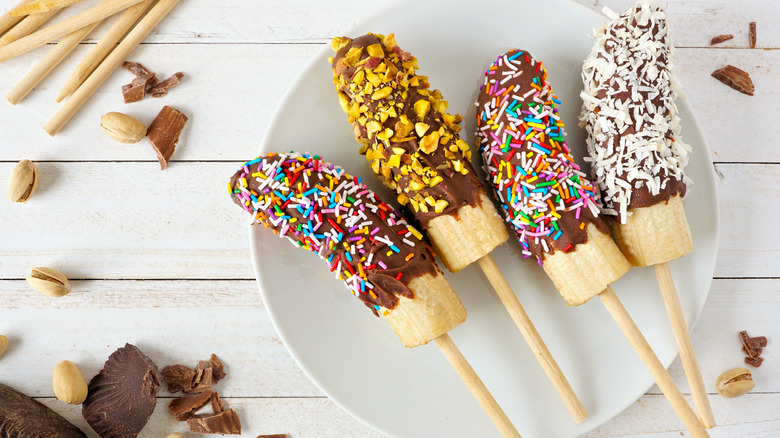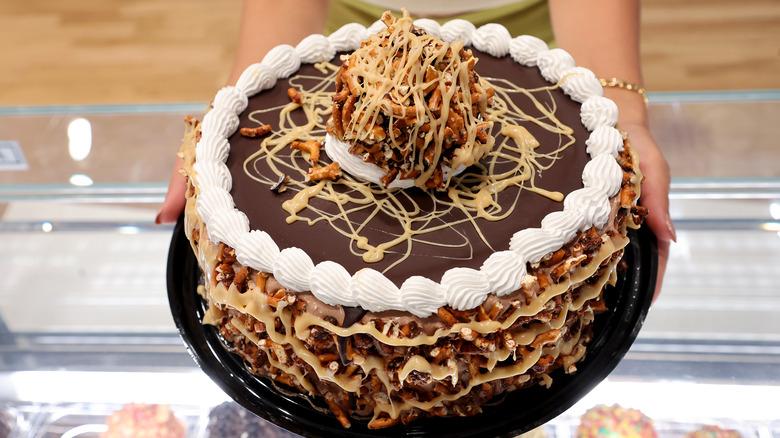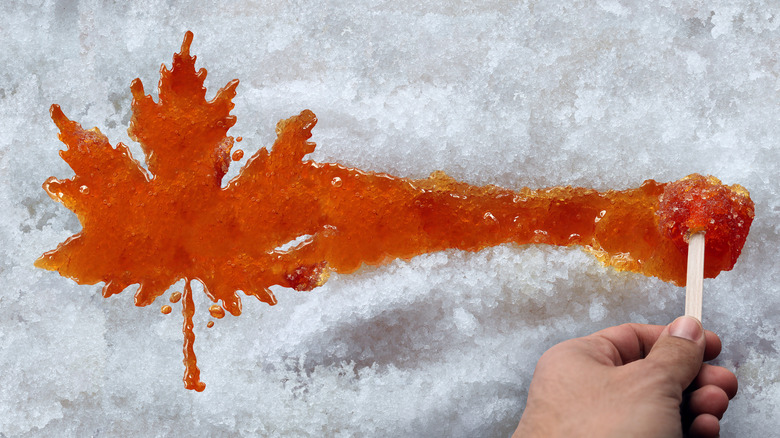20 Types Of Frozen Desserts, Explained
You scream, we all scream — for, gelato? It might not have the same ring to it, but we can both agree that gelato and ice cream are two delicious frozen treats that never seem to lose their novelty. But any ice cream enthusiast will be able to tell you that there is more to ice cream than just, well, ice cream and gelato. According to data from Grand View Research, the frozen dessert market in the United States alone was valued at over $30 billion in 2021 and is expected to grow by at least 5% into the next decade.
The preparation methods and the ingredients for different types of frozen desserts vary but are all arguably delicious. Here's the scoop on some of our favorite types of frozen desserts you can find at the grocery store, local scoop shop, or even make at home with the leftover whipping cream you've been meaning to get rid of.
Gelato
Gelato is the Italian word for ice cream, so it is most common in scoop shops across the peninsula. But the difference between ice cream and gelato is more than just a matter of language. Gelato is made with more milk and less cream than traditional ice creams, so the flavor is much more creamy. There is some difference in the manufacturing process as well; gelato is turned at a slower rate than other types of ice cream.
Gelato, unlike ice cream, is usually stored in a special container so that it does not freeze solid. Gelato is scooped with a paddle-like utensil and scooped into a cup in petal-like layers. And since gelato is less solid than ice cream, it is usually served in a cup where it can be topped with fresh fruit, nuts, or chocolate.
Soft-serve ice cream
Soft-serve ice cream (or as Vermonters call this frozen dessert, a "creemee"), is made from the same ingredients as hard ice cream. The main ingredient between the two major types of ice cream is that soft ice cream has a lower butterfat content than hard ice cream. Hard ice cream usually contained 10% to 13% butterfat, while soft-serve ice cream contains a measly 6% to 8% butterfat (via the Ice Cream Geek). The more butterfat, the richer the ice cream. The method for making soft-serve ice cream also beats more air into the ice cream; the result is a softer mouthfeel than hard ice cream.
Soft-serve ice cream comes in almost any flavor, but the most common varieties you'll see in a scoop shop are vanilla, chocolate, or chocolate-vanilla twist. Redditors theorize that this basic flavor combination is due to the popularity of the standard flavors and companies have caught on to only producing these flavors to cut operational (and cleaning) costs.
Frozen custard
Frozen custard resembles the texture of soft ice cream, but with the addition of a special ingredient. The invention of frozen custard, as noted by Travel Wisconsin, is credited to Coney Island, New York in 1919. Two ice cream vendors noticed that adding egg yolks to ice cream resulted in a smoother texture and an ice cream that could withstand the hot temperature on the boardwalk without melting as quickly. As set forth by FDA regulations, custard must include at least 1.4% egg yolk, along with 10% milk fat. The result is a smoother frozen dessert than typical ice cream. PureWow describes the flavor of custard as rich, dense, and creamy.
Frozen custard can be flavored similarly to typical ice cream; some shops will use the same vanilla base and add colors and flavors based on the desired product. If you'd prefer to eat frozen custard from the store, our favorite brand recommendations include small batches from Culver's or from the conglomerate known as Shake Shack.
Hard ice cream
Hard ice cream has a higher fat content than soft ice cream, thus making it denser and harder than soft ice cream. Hard ice cream manufacturers use a higher butterfat content to develop the traditional hard ice cream texture and flavor with a series of mix-ins including fruit, chocolate, and candy. Polls by Instacart note that the most popular ice cream flavor in the United States is actually moose tracks: made from vanilla ice cream, peanut butter cups, and fudge swirls.
If you want to make hard ice cream, you'll need a few simple ingredients at home. You should use whipping cream to develop the high butterfat content that hard ice cream requires together. Add the whipping cream to milk, vanilla extract, and sugar, and place in your pre-frozen ice cream churner. After your ice cream has frozen for a few hours, it is ready to be scooped into your go-to bowl or waffle cone.
Sherbet
Sherbet usually comes in the nostalgic flavor combo of orange, raspberry, and lime. But otherwise, how much do you know about this childhood favorite?
Sorbet and sherbet have similar origin stories. Sherbet, unlike the fruit-and-sugar base of sorbet, is made with the addition of cream or milk. But there is usually less than 2% milk-fat in sherbet, so it will never come close to the creaminess of ice cream. Another common misconception, as noted by Smithsonian Magazine, is that the word "sherbet" actually has an extra "r": sher-bert. The spelling and pronunciation of the dessert has been sher-bet since the word entered the modern English language in the 1800s — and even before that. In the 1500s, Middle Eastern and Arabic populations started originally called the proto-dessert sharba (for "drink"). The Turks eventually called the dessert şerbet and the Farsi's sharbat (or zerbet). But if you are one of the folks insistent on pronouncing the dessert sherbert, the Merriam-Webster Dictionary has outlined that word as an alternative spelling for sherbet.
Sorbet
Sorbet is one of the treats for our dairy-free friends. Sorbet is a light, fruity dessert made from churning frozen fruit and sugar together — no dairy or eggs involved.
The ease of the sorbet's ingredients makes this frozen dessert easy for amateur home cooks. You can make strawberry sorbet by combining frozen strawberries, lemon juice, and sugar together in a blender. Although you may be tempted to leave the sugar out of the recipe, it is a vital part of catalyzing the reaction. The sugar keeps the ice from becoming too cold and freezing the sorbet rock-solid when it is placed in the freezer. You should also allocate at least two hours for your sorbet to set after it is blended.
You can eat sorbet the same way you'd eat other dairy desserts: in a cone, in a bowl, or topped with sauces and toppings. Plus, the fruit you choose to use for sorbet is versatile, so you can frozen mango, berries, or stone fruits like cherries to craft your personalized dessert.
Frozen yogurt
Frozen yogurt was popularized in recent years with franchise companies like SweetFrog, Menchie's, and Pinkberry. Frozen yogurt emerged in the 1980s as an alternative to dairy ice cream; it was a time when many Americans were concerned with calories and saturated fat intake. In 1978, H.P. Hood released his frozen yogurt to the public and its popularity surged into the 1990s with one of the most popular frozen yogurt chains: The Country's Best Yogurt (TCBY). In current times, frozen yogurt chains have decreased in popularity and consequently closed for several reasons — most of which are the COVID-19 pandemic and the reality that frozen yogurt just isn't as healthy as it was made out to be.
Instead of being made from cream, frozen yogurt is made with frozen cultured milk. While some folks have heralded frozen yogurt as a way to get a tasty dose of probiotics into one's gut, the reality is that most of these healthy microbes are killed off when the yogurt is frozen. Companies also add a bit more sugar to frozen yogurt to balance out the tang from the cultures. But, the lower fat in frozen yogurt compared to traditional hard ice cream is a selling point for many folks.
Mochi
Mochi encroach more into the category of "ice cream novelty" than other types of desserts. The mochi is a hybridized dessert between Japanese and American cultures. Balls of American ice cream are wrapped with pounded glutenous rice. The skin of the mochi is thick and chewy and originally only came in three flavors: green tea (matcha), red bean, and mango. Since mochi have surged in popularity since the 2010s, consumers can now purchase mochi in most major grocery stores in flavors including double chocolate and s'mores.
Homemade mochi ice cream isn't as difficult as it seems to make. You'll first want to wrap your balls of ice cream in the freezer so that it will be easy to handle when you're ready to form and shape the mochi. Then, a sweet glutenous rice flour (mochiko) is combined with powdered sugar and salt and microwaved. Then the dough is rolled, sliced, and cut into circles large enough to encompass the ice cream balls. After the ice cream balls are sealed, the mochi must be frozen for at least two hours before serving.
Nitrogen ice cream
According to ChillN, liquid nitrogen (at -320 F) is used to flash-freeze traditional dairy ice cream or non-dairy ice cream. The result is smaller ice crystal development and a smoother consistency than traditional ice cream, as well as an eerie foggy scene for the molecular gastronomy nerds out there. There is no obvious odor, color, or flavor to this ice cream creation — so you may not know that it would have even been infused with liquid nitrogen. Plus, you can customize the nitrogen ice cream to fit your favorite toppings and flavors because it is made to order.
Although nitrogen ice cream has its scientific and culinary merit, handling liquid nitrogen requires diligence and precision (aka, do not try this at home). If liquid nitrogen is not handled properly, it can cause skin and internal organ damage. Inhaling the vapor from liquid nitrogen (the coveted "dragon's breath") is especially risky for folks with asthma.
Rolled ice cream
Rolled ice cream is commonly found in Thailand and is served by street vendors in major cities like Bangkok. The ice cream base is rolled on a thin, super-cold sheet into tiny, cylindrical rolls before being placed upright in a dish and served with toppings. The sheet, which is also known as an "anti-thermal cold plate" or an "anti-griddle," can reach temperatures below 10 F. The resulting ice cream cools on contact with the sheet and becomes easily pliable and foldable with time.
According to StyleBluePrint, the process of rolling ice cream is both methodical and manual. The crafter pours a liquid mixture onto the plate and moves the liquid around until it becomes slightly frozen, before being prodded, mushed, and spread flat. Then, the crafter can roll the ice cream with a spatula into the rolls before picking up the ice cream with tongs and placing it into the serving dish. Rolling the ice cream too thick, too thin, or before it is solid enough will result in the ice cream falling apart. Thus, we recommend keeping this type of ice cream for the pros — plus it's cool to watch.
Italian ice
We should first start by saying Italian ice isn't actually from Italy. It comes straight from the Americanized version of Italy, mixed with the debauchery of Las Vegas: the Jersey Shore. According to GelU, Italian ice is derived from the Italian dessert called granita — soft ice made from frozen juice, water, and sugar. It is said that a Sicilian woman living on the Jersey Shore wanted the granita of her homeland, so she came up with a similar frozen dessert.
The Italian ice we know in America today is more similar to a sorbet — just without the whole fruit. The flavor of the Italian ice is more pronounced than shaved ice because the ingredients are mixed together prior to being frozen, per DelightedCooking. Plus, consumers can rest assured that Italian ice uses sugar rather than high-fructose corn syrup for sweetness. Since there is no dairy in Italian ice, this frozen dessert is naturally vegan and gluten-free.
Shave ice
Shave ice is a traditional summertime treat by pouring sugary syrup over thinly sliced shaved ice. The dessert has been popular in America because it is easily customizable to include alcohol or to add multiple flavors of syrup into a single cone.
According to Hawaiian Airlines, "shave ice" can be traced back to the island of Hawaii. Kakigori, Japanese for "shave ice," was eaten by Japanese immigrants working in the sugar and pineapple plantations on the island. The immigrants would chop pieces off a block of ice and coat the shave with juice or syrup. Eventually, shave ice began selling in small family grocery stores near the plantation. One of the most famous, Matsumoto Shave Ice sells over 30 flavors of ice with optional toppings like condensed milk, azuki beans, and ice cream.
If you're looking to make shaved ice at home, you'll want to abstain from using pellet ice or chopped ice. Unlike snow cones, shave ice is made using a fine shaving blade that creates a texture of ice similar to that of fallen snow. Shave ice purveyors used hand-cranked machines to craft a delicate texture that easily soaks up the syrup.
Popsicles
The creation of the popsicle was the exact definition of the phrase, "a happy accident." NPR notes that the popsicle was the result of 11-year-old Frank Epperson leaving a mix of soda powder and water out overnight in 1905. When the mixture froze, it stuck to the wooden stirrer and was easy for Frank to tote around and lick off. He dubbed this creation the Epsicle — a combination of his name and icicle. After working on his invention in 1924, Epperson's children convinced their father to rename the invention "Pop's icicle," which became eventually shortened to what we know today as a popsicle.
Popsicles can come in fruity, chocolatey, and boozy flavors. Folks looking to make popsicles at home can turn to popsicle molds to make stabilizing and freezing the popsicle much easier. We recommend using a funnel to transfer the liquid into the popsicle molds and make clean-up simple.
Semifreddo
Semifreddo is one of the lesser-known frozen desserts out there. As the name implies, this frozen dessert is semi-frozen and crafted using a whipping technique rather than churning. This Italian dessert combines traditional ice cream ingredients like cream, sugar, eggs, and heavy cream into more of a mousse texture than typical ice cream. While some crafters of semifreddo add the whipped cream gently into the recipes, others focus on heavily beating the ingredients together to whip more air into the dessert. Once the mousse is soft and airy, it is transferred into a loaf pan to freeze. After a few hours, the mousse is sliced like a loaf to maintain its texture and shape before being garnished and served with fruit or other toppings.
Semifreddo is the perfect dessert to start learning ice cream 101. You won't have to invest in an ice cream churner (which we admit to only pulling out of the closet less than once a year) and you'll get the same flavor and texture as other types of ice cream.
Snow cones
WFAA attributes the creation of the snow cone (and its machine) to Samuel Bert. Bert began selling snow cones at the Texas State Fair in 1919, thus causing the treat to surge in popularity because of its relative cost compared to dairy-based ice creams.
Unlike shave ice, the snow cone is made with finely crushed ice. As a result, the dessert is much more crunchy and the liquid tends to drain to the bottom of the receptacle rather than being immersed in the actual ice. The Hawaiian Shaved Ice Company recommends starting with your syrup around the rim of the cup before moving inwards. Once you reach the top, you'll only have to pour for a few seconds to ensure your snow cone is ready to eat.
Snow cones can come in almost any flavor that someone can make sugar syrup out of. For an adult snow cone, we recommend combining Aperol, sugar, water, mint, and lime zest in a saucepan to make a simple syrup. Then, cool completely before spooning a few teaspoons of the mixture over ice and serve with lime wedges. It's simple, boozy, and screams summertime.
Milkshakes
Milkshakes are a nostalgic childhood beverage made by churning hard ice cream with milk. It is believed that the first versions of milkshakes were boozy and made by combining eggnog with whiskey. In 1886, a Georgia publication noted a new invention in the ice cream world made by combining sweet milk, crushed ice, and desired syrups in a container and shaking the beverage furiously. Hankering for History notes that Walgreens' employee Ivan "Pop" Coulson sought to improve the company's chocolate malt beverage. He experimented with adding the beverage to other ingredients at a local soda fountain; eventually, the addition of ice cream gave the beverage a newfound thickness that would change American diner culture from that point on.
While the most traditional flavors of milkshakes include chocolate, vanilla, and strawberry, the world of milkshakes is open to many more ingredients including avocado, alcohol, cake mix, malt powder, and fruit.
Smoothies
Smoothies technically make the list of "frozen desserts" because the beverage combines fruit (frozen or not) with dairy products, flavorings, and ice. It's cold, refreshing on a hot day, and worthy competition to the more calorie-laden ice cream. The smoothie is customizable based on whatever fruits (and vegetables) you have in your fridge. You can use a variety of yogurts and dairy products for your smoothies as well. Our favorite is a black forest smoothie with frozen cherries, frozen bananas, spinach, milk, flaxseed, and cocoa powder.
Smoothies have been around longer than you'd think. Proto-smoothies were made by cultures around the world by mashing fruits and mixing in fruit juice. With the marketing of the blender in 1938, home ownership of this simple appliance skyrocketed. As health foods started picking up steam in the 1960s through the 1980s, juice bars and smoothie shops started appearing in American strip malls with brands like Smoothie King, Jamba Juice, and Naked Juice.
Frozen bananas
Long before George Michael Bluth was selling bananas on the Newport Beach boardwalk, the frozen banana was getting its start in the American frozen dessert lexicon. According to the Smithsonian Magazine, Don Phillips set up the first frozen banana stand on the same boardwalk in 1940. In 1961, the frozen banana was being dipped in chocolate and nuts and sold at the Arizona State Fair.
To make your own frozen bananas at home, you'll want to start by placing a few bananas in the freezer the day before. Peeling the banana prior to freezing is optimal, but you can also freeze in-peel and slice the peel off with a knife when you're ready to prepare your frozen banana. Dip in melted white, dark, or milk chocolate and top with your favorite mix of nuts, sprinkles, or chocolate chips.
Ice cream cake
Ice cream cake gets the honor of being called both a cake and a frozen dessert. The cake is made by freezing layers of ice cream, sheet cake, frosting, and toppings together. The trick to keeping the ice cream from melting on an ice cream cake is to assemble the ice cream cake in pieces — and freeze it in the meantime. The cake pieces need to be adequately cooled before being assembled to prevent warmth from infiltrating into the frozen layer. To make the ice cream easier to handle, you can spoon the ice cream into a plastic-lined baking dish and set the ice cream in the freezer. Having adequate room on the side of the plastic layer ensures you can easily flip the ice cream onto the cake and pull the plastic layer out.
Sugar-on-snow
Sugar-on-snow is a classic New England winter treat made from just a few ingredients. Some New Englanders call the treat "maple candy" while the Canadians may refer to it as "Tire sur la Neige." You'll need heated maple syrup (around 225 F) and a pile of clean snowfall — or shaved ice. The trick to making sugar-on-snow is to make sure the maple syrup is hot enough that it forms into a thick candy layer when rolled around a popsicle stick, but not so hot that it melts the ice.
Sugar-on-snow, according to Gastro Obscura, is historically eaten with apple cider donut (another New England classic treat) or pickles. The pickles are said to curb the sweetness of the maple syrup and allow for a medley of flavors in every bite.
